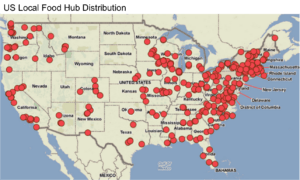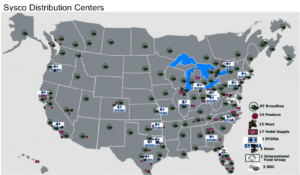Sysco: Squeezed by a Changing Climate in Consumer Demand

How will climate change affect consumers' demand for food, and how will this shift affect the largest US food distributor, Sysco?
Sysco: Squeezed by a Changing Climate in Consumer Demand
Trends in Consumption
Let’s start with a few basic observations. Climate change is happening. As a result, consumers are increasingly aware about the impact that their consumption choices are having on the climate. In the context of food, one outcome of this trend is increasing demand for locally and sustainably sourced food. The National Restaurant Association annually conducts a survey asking 2,000 chefs to rank 198 items based on popularity in the food industry in the oncoming year: two out of the top three trends in 2016 are locally sourced meats and locally sourced produce. Locally sourced food has been in the top three since 2010 driven by a perception[i] that it is better for the environment.[ii]
What Does this Mean for Sysco?
Supply Chain Management: Sysco’s food distribution operation is a low margin, high volume, and high-risk business. Climate change will add significant variability to the supply side of Sysco’s business and thereby expound the company’s risk profile. In order to meet growing demand for local food, Sysco would need to work closer with local producers in order to help them scale their operations to meet increased demand while also enabling them to smooth out increased variability in their yield.[iii]
As shown above, most local food, as measured by $ sales, gets to consumers via food distributors. This is in large part due to major investments by distributors such as Sysco to meet customers’ growing demand. In 2009, Sysco launched its Local Food Initiative in an attempt to meet growing demand for these products. The initiative focused on improving supply chain management through investing in “Good Agricultural Practice (GAP) workshops, educating more than 900 small farmers about how to integrate GAP requirements into their operations”[iv]. This initiative will increase the number of farms certified to supply goods to Sysco and its ability to meet new levels of demand.
In its 10-K, Sysco currently lists climate change as one of the “Conditions beyond our control can interrupt our supplies and increase our product costs”[v]. However, there a number of operational changes Sysco might consider in order to reduce its exposure to the risk of climate change while also meeting consumers’ growing demand for local food. First, Sysco might consider partnering with companies such as Monsanto or Indigo Agriculture to promote the use of GMO or micro-biome enhanced seeds that have higher resistance to changing climate conditions. Their buying relationship with growers could prove to be a strong distribution channel for these companies. Second, Sysco’s current business model focuses on leveraging fewer, larger distribution hubs from which they can aggregate and distribute goods. In addition to this owned infrastructure (~186 distribution centers[vi]), Sysco should consider leveraging and investing in local food hubs, currently estimated at ~329[vii], which serve as independent local food aggregation and distribution centers. Through leveraging the growing network of food hubs, Sysco would diversify its product exposure across farms and manage the risk of lower yields in a particular area.
Meeting Customer Demand: While effective supply chain management will help to ensure that Sysco has the inventory to meet growing demand, Sysco also needs to be able to demonstrate to its customers that it has committed to buying locally and sustainably. Sysco offers suppliers with a number of solutions to streamline ordering and better track items as they move through the distribution chain; however, in the future Sysco will need to look down-market to work with more mid-sized local producers. It is likely that these producers have less experience with technology and integrated inventory management systems, and Sysco will likely need to invest in more user-friendly versions of its eSupplier solutions.
Deeply examining how climate change will shift consumer demand enables us to see how a singular shift in preferences implies a multitude of changes in Sysco’s operational model. It is important to note, however, that this is just one of the many ways in which climate change will effect Sysco’s operations.
[i] Opinions are divided on the environmental impact of local food systems. This post addresses the trend and perception that local food economies are more environmentally friendly than today’s traditional food system.
[ii] National Restaurant Association, “What’s Hot 2016 Culinary Forecast,” http://www.restaurant.org/Restaurant/media/Restaurant/SiteImages/News%20and%20Research/Whats%20Hot/WhatsHot2016_Top20Food_1200x1200.jpg, accessed November 3, 2016.
[iii] Henderson, Rebecca, Sophus Reinert, Polina Dekhtyar, and Aram Migdal. “Climate Change in 2016: Implications for Business.”
[iv] Sysco 2015, “Local Sourcing,” http://sustainability.sysco.com/, accessed November 3, 2016.
[v] Sysco 2015, “Form 10-K,” http://www.sysco.com/aboutus/OnlineAnnual2015/pdf/SYY007_10K_HD.pdf, accessed November 3, 2016.
[vi] Sysco. (2016). The Sysco Story. Retrieved from http://www.sysco.com/about-sysco.html.
[vii] National Good Food Network, “US Food Hubs – Full List,” http://ngfn.org/resources/food-hubs/food-hubs, accessed November 3, 2016.
Word count: [770]






This is a really interesting take on climate change affecting food. We often forget the distributors but your post shows that the impact is quite real and significant!
One thing I thought of as I was reading was the pressure that local growers may feel if they being to work more with distributors like Sysco. Presumably, Sysco has the power in the relationship and probably would demand high quantities of a specific standard. While this is a great opportunity for some of these local players, I wonder if it puts more pressure on them, rather than if they were to deal with a smaller, local distributor. Your post does however mention that Sysco is working with farms to try and help them invest in the right technologies and help them meet new levels of demand so hopefully what I mentioned above is mitigated.
On the flip side, I wonder what this does to the relationships between Sysco and some of the larger, more national manufacturers. If consumers are demanding more local, it must mean that the national guys are suffering. I wonder if and how Sysco is dealing with this. Perhaps it’s just on the national guys to invest in more organic and locally sourced ingredients so that they can compete.
Thanks for writing this. Very interesting!
Such a great read! It’s interesting to see the changing role of distributors in managing consumer demand and supply gaps. It’s interesting to see that these initiatives (building scale of local producers) are driven more by changing perceptions about locally sourced food, rather than actual changes in food availability due to climate change. I wonder whether in the long run (when the impacts of climate change are more drastic) Sysco’s high reliance on smaller producers will negatively affect them. The assumption being that larger scale producers will be better equipped to deal with the adverse impacts of climate change due to their scale. It would be interesting to see if Sysco is also in parallel investing in partnerships with larger scale farmers who have adopted more sustainable practices. Again, thank you for writing this!
great article. I just wanted to build upon shivika’s point above that Sysco should also prepare for the actual effects of climate change, in addition to just responding to consumer perceptions. It can partner with local farmers on better farming practices such as drip irrigation or laser land leveling that reduce the farm footprint on natural resources. This way, it will be able to market local products as more environment friendly and will actually manage its supply chain risk in the face of climate change